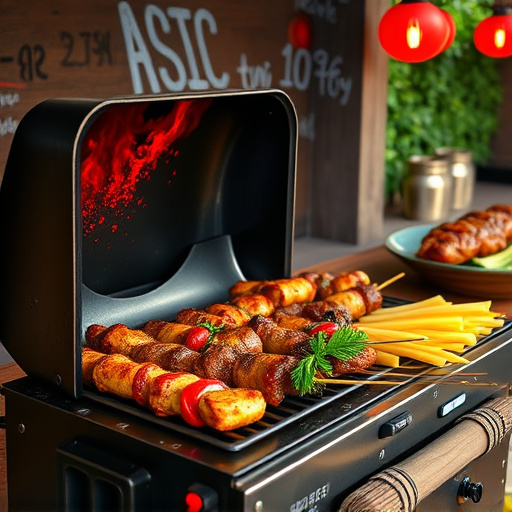Selecting lean cuts like sirloin or round steak for DIY BBQ jerky ensures quality and longevity. Dry brining with a spice blend enhances flavor and tenderness. Craft your own spice blends with paprika, garlic powder, salt, pepper, and more. Smoke at 105°F-125°F (40°C-52°C) for 4-8 hours to achieve tender jerky. Store in an airtight container for up to a month. Experiment with unique flavors and proteins for personalized BBQ jerky recipes.
Looking to make tender, mouthwatering BBQ jerky at home? This comprehensive guide covers everything you need to know. From selecting the right meat for your DIY jerky to mastering dry brining, creating flavorful marinades, and achieving perfect smoking temperatures, we’ve got you covered. Learn cutting and drying techniques, storage tips, and even unique flavor ideas. Elevate your BBQ game with this ultimate BBQ jerky recipe.
- Selecting the Right Meat for BBQ Jerky
- Dry Brining Technique: A Step-by-Step Guide
- Spices and Marinades: Creating Flavor Profiles
- Smoking at the Right Temperature for Tender Results
- Cutting and Drying Jerky: Tips for Success
- Storage and Shelf Life of Homemade BBQ Jerky
- Experimenting with Unique Flavors and Recipes
Selecting the Right Meat for BBQ Jerky
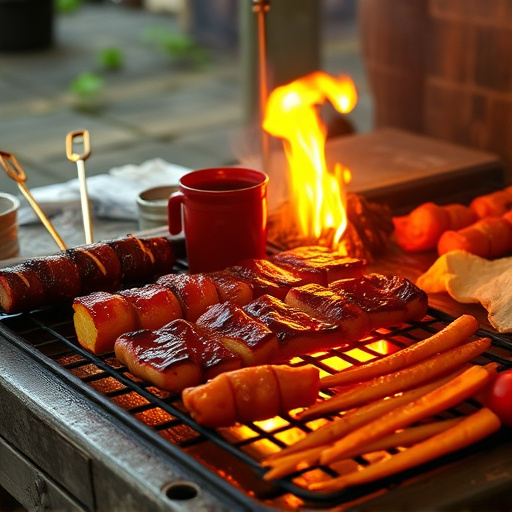
When crafting your perfect BBQ jerky at home, choosing the right meat is half the battle won. Opt for lean cuts of beef, such as sirloin or round steak, as they tend to work best due to their lower fat content. This ensures that your jerky doesn’t become greasy or unappetizing when dried. A good quality, well-marbled cut will provide both flavor and tenderness, resulting in a more satisfying BBQ jerky recipe.
Avoid fatty cuts like brisket or rib eye, as the excess fat can go rancid quickly and make for an unpleasant eating experience. Instead, focus on finding a balance between meat texture and fat content to create a delicious, long-lasting BBQ jerky that will satisfy your cravings.
Dry Brining Technique: A Step-by-Step Guide
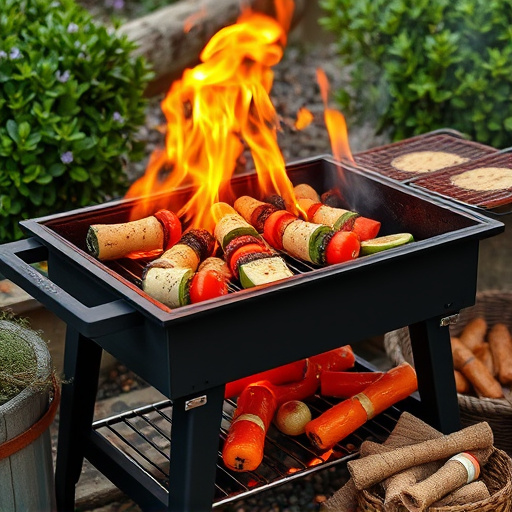
Dry Brining is a time-honored technique that significantly enhances the flavor and tenderness of your DIY BBQ jerky. This method involves marinating raw meat in a mixture of salt, spices, and other aromatics before drying it. Here’s a simple step-by-step guide for achieving perfect results with your BBQ jerky recipe:
1. Prepare the Brine: Start by mixing coarse sea salt or kosher salt (about 3/4 cup per 5 pounds of meat) with your choice of spices and aromatics. Common additions include garlic powder, onion powder, paprika, black peppercorns, chili powder, and a splash of liquid smoke for an extra smoky flavor. You can also add brown sugar to balance the saltiness, but it’s optional.
2. Submerge the Meat: Place your cut meat (beef or deer are popular choices) in a large resealable bag or a non-reactive container. Pour the brine mixture over the meat, ensuring it’s fully submerged. For best results, use a weight to keep the meat underwater if necessary. Refrigerate for 5–7 days, flipping the bag or stirring the contents daily to ensure even brining.
Spices and Marinades: Creating Flavor Profiles
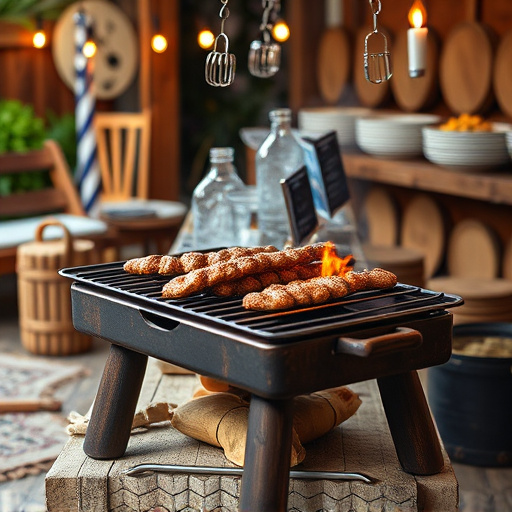
Creating a delicious BBQ jerky at home starts with the perfect spice blend or marinade. This is where your creativity can shine, as the right combination of flavors will transform simple beef strips into mouthwatering snacks. A classic BBQ jerky recipe incorporates a mix of paprika, garlic powder, salt, pepper, and onion powder, offering a balanced blend of smoky, savory, and slightly spicy notes.
Experimenting with additional ingredients like chili powder, cumin, or liquid smoke can add depth to your flavor profile. For a sweeter twist, consider adding brown sugar or honey to balance the heat. Marinading the meat for an extended period allows these flavors to penetrate deeply, ensuring every bite is packed with complexity and richness.
Smoking at the Right Temperature for Tender Results

To achieve tender and delicious BBQ jerky at home, mastering the art of smoking is key. The ideal temperature range for smoking jerky falls between 105°F to 125°F (40°C to 52°C). This might seem lower than you’d expect for cooking meat, but it’s crucial for breaking down collagen and making your jerky incredibly tender. Higher temperatures can lead to quicker results but may result in chewy or tough jerky.
Maintaining a consistent temperature throughout the smoking process is essential. Consider using a digital thermometer to monitor the smoke oven temperature and make adjustments as needed. This precision ensures that your BBQ jerky recipe turns out perfectly, with just the right balance of flavor and texture.
Cutting and Drying Jerky: Tips for Success
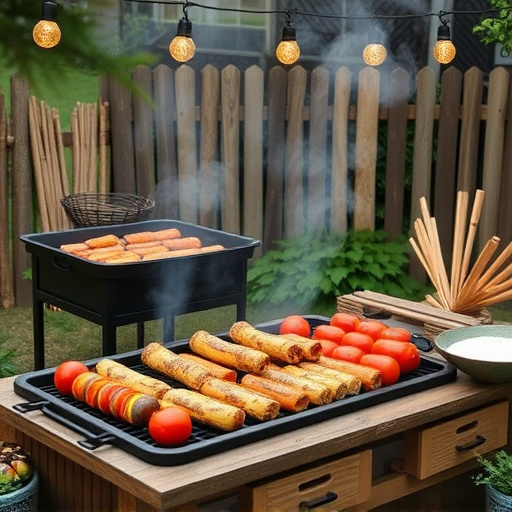
When preparing your BBQ jerky at home, cutting and drying are crucial steps to ensure a tender and flavorful final product. Start by trimming any excess fat from your chosen cut of meat – beef or chicken work well for jerky – as it can make the final texture tough. Cut the meat into thin strips; this allows for even cooking and faster drying, resulting in a more tender jerky. Aim for a thickness of around 1/4 inch (0.6 cm) to achieve that perfect balance between crispiness and tenderness.
For optimal results, use a food dehydrator or your oven on the lowest setting with the door slightly ajar. Drying is essential to removing moisture from the meat, which prevents bacterial growth and helps preserve your BBQ jerky recipe. Set a timer for several hours – anywhere from 4 to 8, depending on your preferences and equipment – and check on your jerky regularly. The goal is to achieve a desired level of dryness without overcooking, ensuring your jerky stays tender and flavorful.
Storage and Shelf Life of Homemade BBQ Jerky
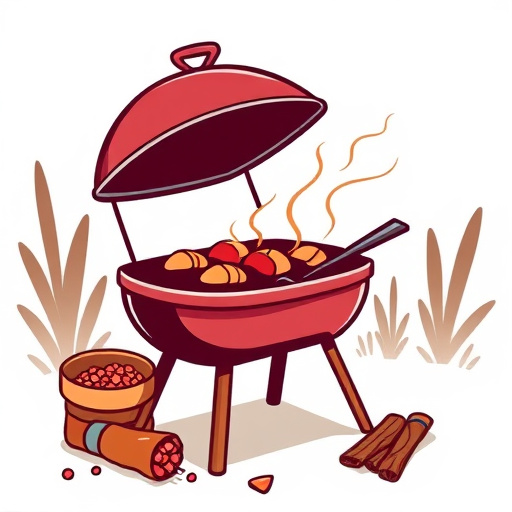
After making your delicious homemade BBQ jerky, proper storage is key to maintaining its quality and extending its shelf life. Store your jerky in an airtight container or a resealable plastic bag, ensuring it’s kept away from direct sunlight and heat sources. This will prevent oxidation and maintain its crispness. Label the container with the date of preparation for easy tracking.
Homemade BBQ jerky typically lasts for 1-2 weeks when stored properly. If refrigerated, it can last even longer, reaching up to a month. However, remember that while jerky is safe to consume beyond these periods, its quality and flavor may deteriorate over time. Always inspect the jerky for any signs of mold or off odors before eating, and discard any batches that don’t meet your standards.
Experimenting with Unique Flavors and Recipes
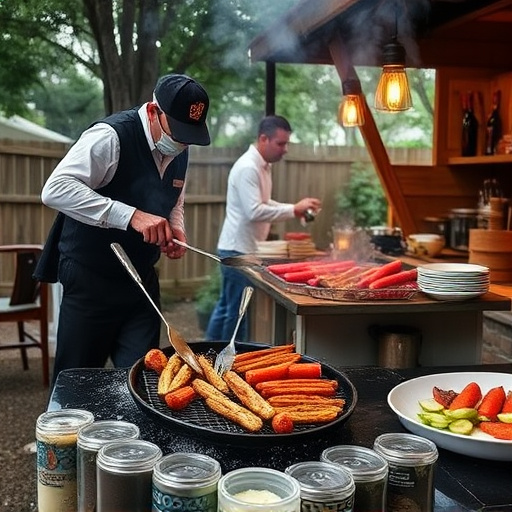
Creating your own BBQ jerky at home allows for endless creative possibilities. Once you’ve mastered the basic BBQ jerky recipe, don’t be afraid to experiment with unique flavors and recipes. Spices like chili powder, cumin, and smoked paprika can add a smoky, spicy kick. For a sweeter option, consider adding brown sugar, maple syrup, or even a touch of vinegar for tanginess. You can also get adventurous with your protein source—goats, venison, or even turkey can be excellent alternatives to traditional beef jerky. Don’t hesitate to blend different marinades and seasonings to craft distinctive flavors that cater to your taste buds.
